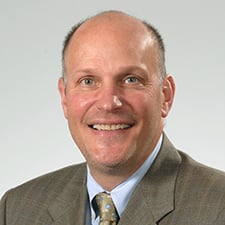Philip M. Oravetz, MD, MPH, chief population health officer at Ochsner Health, in Louisiana, has some crucial advice for other health systems mulling value-based contracts. Before signing, get a commitment from your payers to provide claims data.
This has been a sticking point for the move to value-based care for many years, said Dr. Oravetz, who provides physician leadership to Ochsner’s systems portfolio of value-based contracts. These include commercial shared savings and full-risk capitation within Medicare Advantage.
Payers often have a critical view of what’s going on with patients compared with physicians and health care organizations, “because the claims data holds knowledge that is critical at the practice level,” he said.
Dr. Oravetz discussed the path to success with Ochsner’s value-based initiatives with Suja Mathew, MD, executive vice president and chief clinical officer at Atlantic Health System, during a virtual meeting of the AMA Insight Network.
The AMA Insight Network helps AMA Health System Program members gain early access to innovative ideas, get feedback from their peers, network, and learn about pilot opportunities. Learn more.
A “quadruple aim” of value
Ochsner Health is the largest integrated delivery system in the Gulf South, offering care throughout Louisiana, parts of Mississippi and Alabama. The system has experienced a 17-year period of growth and expansion, managing two medical schools while overseeing clinical trials and other research, said Dr. Oravetz.
“And now we've added this portfolio of value-based care,” he said. Value-based contracts operate on four key elements: improving population health to improve quality; elevating the patient experience of care; turning fee-for-service into fee-for-value; and providing well-being and caring for caregivers.
“We have total capitation contracts where we are responsible for all gains and all the losses, including pharmacy and hospital post-acute care. We take responsibility for the total spend of the patient, in addition to patient experience and quality,” summarized Dr. Oravetz.
Using data to improve quality
To achieve good quality outcomes, Ochsner put a system into place to “marry” claims to clinical data in new ways and feed it to practices at the point of care.
Each practice has a quality coordinator, and all data comes from a shared electronic health record. For the last eight years or so, the health system has integrated data from disease-focused registries on diabetes, hypertension, cancer and other conditions into the workflow of its provider offices.
As soon as a physician opens a chart, they can see where the care gaps are and start closing those gaps. This allows them to have a better view of care as they see patients day in and day out, said Dr. Oravetz.
A platform for population-based care
Using EHRs to look at one patient at a time “is one of the most wasteful things we do in healthcare,” noted Dr. Oravetz. “You really do need a platform outside of your EHR ... that can organize those claims into meaningful ways.”
Ochsner’s external software platform uses a claims grouper to evaluate the totality of care spend for specific patient populations. Through this method, “you can start coming up with interventions one by one, across the entire continuum, to start understanding how to reduce variation and make care more efficient,” he explained.
Once a health system understands where their high-level savings opportunities are, they can focus resources on those programs and take on more risk, he continued.
Such changes don’t take place overnight. Ochsner’s Medicare accountable care organizations, for example, took five years to generate savings and get to enough interventions to impact the total cost of care. Now, these ACOs are successfully generating shared savings.
Embedding doctors to improve behavioral health
Ochsner has also integrated behavioral health resources, social workers, and psychologists into its primary care practices. Under the traditional referrals process, patients often must wait several months to see a behavioral health specialist.
Under Ochsner’s system, “I can literally walk you down the hall so we can get your therapy started,” said Dr. Oravetz.
The AMA Health System Program provides enterprise solutions to equip leadership, physicians and care teams with resources to help drive the future of medicine.




